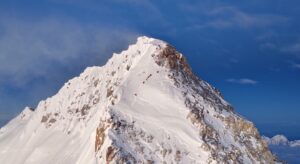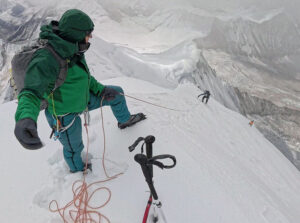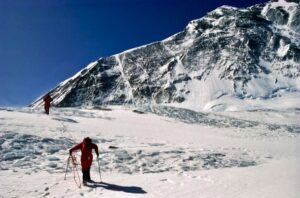Billi Bierling is a great source of information for an overview of the evolution of climbing in Nepal. Besides her work with The Himalayan Database, she is also a climber. Currently, she is on her way to Dhaulagiri. Bierling confirms what many of us have feared. The time of the long, adventurous expeditions in the Himalaya is over.
Bierling is doing something quite offbeat by contemporary standards: She is actually trekking (!) to Dhaulagiri Base Camp with a team organized by Swiss outfitter Kari Kobler Expeditions.
“Trekking to Base Camp is old-school, barely done nowadays,” she says. “Doing one 8,000’er per season is also old-school. Times have changed. People have no time anymore.”

A quaint approach to Dhaulagiri Base Camp — on foot! Photo: Billi Bierling
In Nepal, COVID is in the past
This season, she says, COVID seems in the past. People in Kathmandu again wear masks just to protect themselves from pollution, not viruses.
“People just don’t talk about it anymore,” Bierling said. “Mandatory tests are over. But most of all, the trekkers are back. That is a big difference compared to last year.”
On the other hand, she noted, the war in Ukraine has kept everyone from that country out of the game, except for Antonina Samoilova, who hopes to plant the yellow-blue flag on top of Everest. The war has also made some other European climbers postpone their plans, uncertain about Russia’s next movements.
“Some people just don’t see the point of climbing a mountain when there’s a war, which is fair enough,” she said.
The season also lacks those smaller teams doing alpine-style climbs. But according to Bierling, this is the norm for spring, when Everest and the other 8,000ers gobble up all the outfitters’ resources.

Climbers arrive at Dhaulagiri’s summit on April 9. Photo: Tracee Metcalfe
“The extremely early summits on Dhaulagiri [last weekend] and Annapurna last year, both led by Mingma G, are remarkable,” Bierling said. “Mingma G is revolutionizing the traditional expedition style. Climbing these mountains so early in the year was previously unheard of. Now it is happening more and more, maybe due to the changes in the weather.”
The new expedition life
Such early climbs draw heavily on aerial transport to save time. “The fact is, there is a new style of expedition,” says Bierling.
She cites as an example her friend Tracee Metcalfe. The American arrived in Kathmandu on March 31 and summited Dhaulagiri with Imagine Nepal on April 9.
“That was fast, possibly even too fast for her, but Mingma G did it safely,” said Bierling. “I am not sure how much O2 they used, but I’d guess they would have used it from Camp 2.”

Tracee Metcalfe, on top of Dhaulagiri just nine days (!) after landing in Nepal. Photo: Tracee Metcalfe
Bierling also believes that the trend of climbing several peaks in one season here to stay.
“Yes, climbing only a peak a season is almost old-school as well. Once you are in Nepal, you just keep going. After Dhaulagiri or Annapurna you go to [a bigger one], maybe Makalu or Kangchenjunga. And maybe even a third. This is a completely new and younger style of doing expeditions. And I take my hat off because I do one peak and I am absolutely knackered.”

The good old days: Billie Bierling on the summit of Cho Oyu (which she climbed without supplementary O2), 2005. Photo: Billibierling.com
Climbers rarely trek now
So why is she trekking to Base Camp?
“For me, trekking to the base of an 8,000m peak is part of the journey. You get to know where you are, you meet the people in the area and see how they live, you learn a little bit about them. This way, the summit becomes a little less important, even though it’s always great to have.”
Bierling adds: “I am not saying this is better, just different. Logistics allow for much faster expeditions. Our lives, in general, have changed so much through technology, and this reflects on expedition logistics too.”
Good old times vs safer times?
“Those of us who have been around longer sometimes look back to the good old days when we spent four to five weeks in a base camp,” she says. “We used to hang around, to party, and that’s all gone…People have less time and probably more money. But I think they still enjoy it.”

Left to right, Uta Ibraini of Kosovo and Viridiana Alvarez of Mexico (going for Makalu) with Billi Bierling in Kathmandu. Photo: Uta Ibraini
“On a positive note, this new way of managing expeditions may be actually safer,” Bierling said. “Mingma G’s operation on Dhaulagiri was very safe, and he got his people up to the top and down as quickly as possible. Mingma G is breaking new ground in his own country.”
Finally, the return of trekkers to Nepal has become even more vital to the economy than it used to be. “For instance, the tea houses in the Everest region are not making money out of expeditions because of the helicopters,” she points out. “It’s the trekkers who stay in lodges along their way.”






